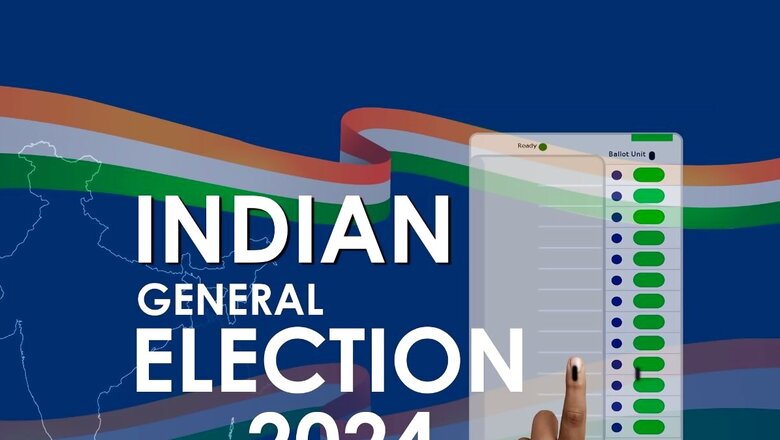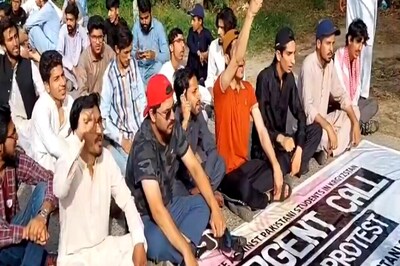
views
The Ahmednagar Lok Sabha constituency, located in Maharashtra, is among the 48 parliamentary constituencies in the state. Classified under the General category, it covers a portion of the Ahmednagar district. At present, the Ahmednagar Lok Sabha constituency comprises six legislative assembly segments: Shevgaon, Rahuri, Parner, Ahmednagar City, Shrigonda, and Karjat Jamkhed, all situated within the Ahmednagar district which has recently been renamed as Ahilya Nagar. The current MP is Dr Sujay Radhakrishna Vikhe-Patil of BJP since 2019. The candidates in the fray for the 2024 Lok Sabha Elections are Vikhe-Patil and Nilesh Lanke of NCP-SP. The constituency will vote in phase 4 on May 13 and results will be declared on June 4.
Political Dynamics
- BJP Banks on Vikhe-Patil’s Family Legacy: The BJP has nominated sitting MP Dr Sujay Vikhe Patil from the Ahmednagar constituency, a BJP bastion since 2009. In 2019, Vikhe had won the seat with a lead of 2,81,474 votes and a vote share of 58.5 per cent against his NCP opponent Sangram Arunkaka Jagtap. Sujay Vikhe, a neurosurgeon and fourth-generation leader, comes from a powerful political family in western Maharashtra. The Vikhe-Patils have maintained tremendous sway over Ahmednagar for decades and are credited with establishing Asia’s first cooperative sugar mill. The cooperative movement in the region was spearheaded by the Vikhe-Patils across four generations. Sujay Vikhe is the grandson of esteemed politician Balasaheb Vikhe Patil, who served as a Member of Parliament for seven terms. Balasaheb Vikhe Patil also held positions as Union Minister of State for Finance and as Union Cabinet Minister for Heavy Industries in the Government of India. His autobiography was released by Prime Minister Narendra Modi in 2020, who said that “stories of Vikhe Patil’s life are found in every region of Maharashtra” citing his work towards the development and betterment of society. Sujay Vikhe-Patil’s father and former Congress leader Radhakrishna Vikhe Patil is the current Minister for Revenue in the state and has served as an MLA for seven consecutive terms from the Shirdi Vidhan Sabha assembly seat in Ahmednagar district. The father-son duo was earlier in the Congress and defected to the BJP in 2019. Notably, he was the first minister to be sworn in during the expansion of the Eknath Shinde ministry on August 9, 2022, following Eknath Shinde and Devendra Fadnavis in the Cabinet Expansion.
- Vikhe’s SWOT Analysis: Needless to say, Vikhe comes from a very well-established political family with deep pockets. As an MP, he has been credited with a plethora of development works, including widening of roads, improved highway connectivity and an enhanced internal road network penetrating deep inside rural areas. However, the leader has his own shortcomings contributing to the anti-incumbency factor. Most locals say that he is not accessible to the people and has lost touch with the people at the ground level. Moreover, as a former Congress leader, he faces some discord internally in the BJP ranks. One more challenge for the BJP is the brewing wrath of Maratha voters, who are allegedly miffed over how the Maratha Reservation agitation led by Manoj Jarange was handled by the BJP-Shiv Sena (Shinde) government. The BJP, despite its decision to sign off on a 10 per cent separate quota for Marathas, is accused of dragging its feet on the matter, and reacting harshly towards Jarange’s hunger strike. Marathas form a pivotal chunk, an estimated 30-35 per cent of the vote here, so it is a concerning issue for the party.
- Unhappy Farmers: Farmers in the region are facing a problem of fallen revenues, especially with respect to onion prices. The government’s decision to hike export duties on onions last year led to a drastic fall in prices in APMCs. This triggered a huge loss for farmers who had been storing onions for prices to surge. In reaction to this event, widespread protests ensued with all APMCs in Nashik and Ahmednagar districts closing down and protesting farmers blocking state highways. This has also dampened the Modi factor to some degree which is otherwise intact in urban areas. These issues have led to a sense of uncertainty surrounding the election, giving way to a tight contest for the BJP. However, the party still has the Modi factor, its Hindutva image, a formidable grassroots machinery and strong booth-level management in place to rely on. Moreover, the Vikhe-Patil family legacy has an emotional bearing on the people, especially among older voters. Take this for example — in 2022, the family’s Dr Vithalrao Vikhe Patil Foundation “adopted” 285 families of farmers who had died by suicide in the district, providing economic support as well as education for the children of the deceased farmers. It’s stories like these that have held the reputation of this family in place for four generations.
- Advantage of Split: Moreover, the BJP benefits from the split in the NCP and the Shiv Sena. The Mahayuti alliance currently has three MLAs, two from BJP and one from NCP (Ajit Pawar). With the Shiv Sena (Eknath Shinde) and the NCP-Ajit Pawar on its side this election, expectations are that the BJP candidate will scrape through with a narrowed margin against his Maha Vikas Aghadi rival.
- Vikhe Patil vs Pawar Feud: In the 1990s, a sensational feud played out within the Congress between Balasaheb Vikhe Patil and a young Sharad Pawar, the repercussions of which are reverberating till this day. In the 1980s, Pawar befriended two leaders, Yashwantrao Gadakh and Ramrao Adik, who were Balasaheb Vikhe-Patil’s political adversaries. Tensions came to a head between the two in 1991. As he gained control of the state Congress by the early 90s, Pawar ensured that Balasaheb was not given a ticket for Lok Sabha elections, who went on to contest independently and lost narrowly with Pawar backing Gadakh against him. During the campaign, the war of words heated up, and Pawar was taken to court by Vikhe Patil for defamation — a case that Vikhe Patil won, and which led to Sharad Pawar getting pulled up by the court and losing his right to vote in one election. Even after four decades, the political rivalry remains visible as Sharad Pawar recently mounted an attack on the family saying, “Some people have been leading the Ahmednagar district for the last 50 years. Earlier generations were honest, but the next generation stopped the development of the district. The new generation behave rudely with seniors.” He also accused the family of stopping the Nilwande dam project and the establishment of government medical colleges in the district.
- Common Man Against Family Raj: The NCP-SP has chosen “common man” Nilesh Lanke as its candidate from the MVA, a first-generation politician who commenced his political journey as a gram panchayat member in 2010 and later became the MLA of the Parner assembly segment after joining the undivided NCP before the 2019 assembly elections. Despite initially siding with Ajit Pawar during the party split, Lanke switched back to the Sharad Pawar faction to contest the Lok Sabha elections and secured a ticket. When Ahmednagar was allotted to the BJP in the Mahayuti seat-sharing agreement, Sharad Pawar was certain that he must field a strong candidate against the BJP’s likely candidate Sujay Vikhe Patil. For this reason, he pursued Parner’s MLA Lanke who had an impressive resume. Lanke is a young leader with considerable sway among the youth. Moreover, his performance as an MLA during the Covid-19 pandemic won him admiration across the nation. He ran a Covid-19 care centre where thousands of patients received treatment free of cost. This feat has apparently earned him a great reputation in a short time span. Lanke is also known to be an accessible leader to the common man which is an edge he has against his Mahayuti rival. He is strongly backed by Sharad Pawar who has been endorsing him vehemently, and mounting attacks on the Vikhe Patil family. With a stronghold in the Parner assembly seat, and the support of the other two NCP-SP MLAs in the constituency from Rahuri and Karjat Jamkhed, Lanke has a formidable base to lean on. Lanke is also poised to garner the support of a large part of the minority Muslim community. Lanke’s projected commitment to serving the common man and his grounded approach may work in his favour.
Key Issues
- Communal Tensions: On May 15 last year, communal clashes broke out in Ahmednagar. People from both communities have lived peacefully for decades in the region but the clashes have changed the picture. More than 12 civilians and seven police personnel were injured during the clashes that broke out near the local mosque during a procession taken out to mark the birth anniversary of Chhatrapati Sambhaji Maharaj in Shevgaon. This has been the case across Maharashtra where communal tensions have been rising over the last few years.
- Droughts: Ahmednagar is one of India’s most drought-prone areas. Erratic rains and longer and harsher summers have caused immense water scarcity in the region. In 2005, 2007, 2013 and 2016, Maharashtra faced massive droughts and Ahmednagar region was one of the worst-hit as people did not have access to potable water for days and in some areas for more than a week. Instead of the issue being addressed, acute water shortage has intensified in the region. According to reports, the frequency and intensity of extreme droughts have increased four times in the Ahmednagar district since 1970.
- Farmer Issues: Water scarcity and inability to irrigate their fields has become one of the most pressing issues for farmers in Ahmednagar. The soil in the region has low fertility and requires more fertilizers and pesticides, increasing the cost of production. In the last 10 years, many farmers have abandoned their fields and have moved towards urban centres such as Pune and Mumbai for work. With no traditional river water source, farmers have to depend on rainwater for their irrigation needs. Unpredictable and declining rainfall has made agriculture unviable. Those who could afford it have shifted to sustainable practices such as watershed management and using diffusers for effective irrigation. Another issue is the falling prices of onion, sugarcane and milk which has miffed farmers. Farmers in Ahmednagar and across Maharashtra have also protested against the hike in export duty of onions. Scarcity of water coupled with higher production costs, lower selling costs and high export tariff means farmers are not able to sell their produce for substantial profit, which exposes them to financial uncertainty.
- Garbage Disposal and Dumping: Ahmednagar faces a serious waste management crisis, generating over 110 metric tons of garbage per day, much of which is improperly disposed of in a depot or directly into the Sina River, resulting in unsanitary living conditions. The problem goes beyond the city, since the entire district lacks effective garbage disposal facilities, resulting in overflowing landfills that pose major health hazards from disease and poisons. The issue is made worse by inadequate sewage facilities, which expose citizens to illnesses and leave 60 per cent of the city without appropriate sanitation.
- Crumbling Infrastructure: The population growth rate has decreased to 14.10 percent during the last decade as a result of drop in employment opportunities in the city. However, infrastructural facility expansion is low and there is lack of infrastructure to meet the population’s needs. Suburban and expanded areas lack adequate infrastructure. There are no asphalt roads, sewerage drainage, adequate and clean water supply, electricity, health facilities, or public toilets for the poor, among other things. The daily drinking water needed for the more than 3.5 lakh people is 89 million litres, but there is a 39 million-litre deficit. This indicates that only 50 million litres of water have been delivered to the city falling significantly short of meeting its needs.
- Encroachments and Congestion: Even today, Ahmednagar’s core area and neighbouring towns in the region suffer the challenges of small streets on the one hand, and congestion and traffic jams on the other. Streets were constructed long before motorised transportation, and a shortage of parking facilities is the primary source of congestion. Many hawkers and retailers line both sides of the highways, as do motorbikes, cars, tempos, and other vehicles. All of these limit movements to a small lane, and the number of narrow streets, sharp bends, and waits to enter into lanes of traffic slow down movement and cause even more congestion. The same issue has been witnessed between Central ST Stand and Chandani Chowk due to traffic congestion caused by various sorts of vehicles, particularly on market days and other festival days.
- Maratha Reservation: Manoj Jarange Patil’s Maratha reservation agitation made significant waves in the Ahmednagar district despite it not being located in the Marathwada region. Since over 30 per cent of the vote comprises Marathas here, it has resonated with the population. A huge number of people attended Jarange’s demonstration on January 20. The police’s use of force against Jarange and other demonstrators in December last year infuriated the public, who sympathised with him because they thought he was defending Maharashtrian rights. Although the government’s 10 per cent quota concession was a start in the right direction towards resolving community needs, the clamour for inclusion in the OBC category speaks to a deeper level of dissatisfaction. Voter dissatisfaction has been exacerbated by the impression that the BJP administration has been sluggish in addressing the issue.
Infrastructure Development
- Flyover on National Highway-61: In November 2022, Gadkari inaugurated the construction of 3.8 km long four-lane elevated structure flyover at Ahmednagar at a cost of Rs 331.17 crore.
- Pune-Aurangabad Economic Corridor: It is an under-construction 222 km project, which passes through Shirur, Ahmednagar, Shani Shingnapur under the Bharatmala project of the Union government. It will provide better connectivity to the region and help connect Ahmednagar with major economic hubs.
- Khed-Sinnar Section of the Delhi Mumbai Industrial Corridor: It passes through 3 districts viz. Pune, Ahmednagar and Nashik. Four-laning of 109.5 km has been completed, including Nashik and Ahmednagar District. The whole project is being built at a cost of Rs 1,348.20 crore.
- Sakri-Beed National highway: The New NH will connect Sakri to Beed via Ahmednagar. The total length of the project will be 308kms.
- NH-9: Another national highway is being built in Ahmednagar which will connect Ahmednagar with Tembhurni. The total length of the highway will be 150 kms.
- Health Infrastructure: In 2023, three primary healthcare centres in Ahmednagar were inaugurated along with Dr Vikhe Patil Cancer Centre and Dr Vikhe Patil Nuclear Medicine Centre. Mansukh Mandaviya also inaugurated the construction of the main building & staff quarters of the Ralegan Siddhi Primary Health Care Centre (PHC).
- Surat-Ahmednagar Greenfield project: The Surat-Ahmednagar segment of the green field project under PM Gati Shakti is projected to help the general socioeconomic development of tribal and backward areas like as Navsari, Valsad, and Nashik by providing quick and convenient connection.
- Ahmednagar-Beed-Parli Vaijnath new rail line: A new rail line is being constructed from Ahmednagar to Parli at a cost of Rs 4805.17 crore. It will enhance connectivity in the Marathwada region.
- Railway Infrastructure: LED lamps were installed across various locations, enhancing visibility and safety. Road Over Bridges (ROBs) and Road Under Bridges (RUBs) were constructed to eliminate level crossings and ease traffic flow. Ahmednagar station received escalators and improved platform covers, while other stations benefited from electronic train indicators, online booking facilities, and water vending machines. Daund-Manmad section saw track electrification and platform upgrades, along with the installation of butterfly type shelters for passengers.
Demographics
Total Voters: 1831537 (2019)
Social Composition
• SC: 12.6%
• ST: 8.3%
Religious Composition
• Hindus: 91%
• Muslims: 7.06%
• Buddhists: 0.75%
• Jains: 0.86%
Stay updated with live coverage of Lok Sabha Election 2024 Phase 3 Voting In Karnataka And Gujarat on our website. Get the latest updates, polling trends, result dates and more.




















Comments
0 comment